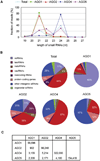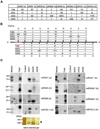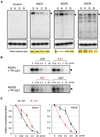Sorting of small RNAs into Arabidopsis argonaute complexes is directed by the 5' terminal nucleotide
- PMID: 18342361
- PMCID: PMC2981139
- DOI: 10.1016/j.cell.2008.02.034
Sorting of small RNAs into Arabidopsis argonaute complexes is directed by the 5' terminal nucleotide
Abstract
Argonaute (AGO) proteins recruit small RNAs to form the core of RNAi effector complexes. Arabidopsis encodes ten AGO proteins and a large network of small RNAs. How these small RNAs are sorted into specific AGO complexes remains largely unknown. We have cataloged small RNAs resident in four AGO complexes. We found that AGO2 and AGO4 preferentially recruit small RNAs with a 5' terminal adenosine, whereas AGO1 harbors microRNAs (miRNAs) that favor a 5' terminal uridine. AGO5 predominantly binds small RNAs that initiate with cytosine. Changing the 5' terminal nucleotide of an miRNA predictably redirected it into a different AGO complex and alters its biological activity. These results reveal a role for small RNA sequences in assorting among AGO complexes. This suggests that specialization of AGO complexes might involve remodeling the 5' end-binding pocket to accept certain small RNA sequences, perhaps explaining the evolutionary drive for miRNAs to initiate with uridine.
Figures







Comment in
-
Sorting out small RNAs.Cell. 2008 Apr 4;133(1):25-6. doi: 10.1016/j.cell.2008.03.015. Cell. 2008. PMID: 18394983
References
-
- Adenot X, Elmayan T, Lauressergues D, Boutet S, Bouche N, Gasciolli V, Vaucheret H. DRB4-dependent TAS3 trans-acting siRNAs control leaf morphology through AGO7. Curr. Biol. 2006;16:927–932. - PubMed
-
- Allen E, Xie Z, Gustafson AM, Carrington JC. microRNA-directed phasing during trans-acting siRNA biogenesis in plants. Cell. 2005;121:207–221. - PubMed
-
- Ambros V, Lee RC, Lavanway A, Williams PT, Jewell D. MicroRNAs and other tiny endogenous RNAs in C. elegans. Curr. Biol. 2003;13:807–818. - PubMed
-
- Aravin A, Gaidatzis D, Pfeffer S, Lagos-Quintana M, Landgraf P, Iovino N, Morris P, Brownstein MJ, Kuramochi-Miyagawa S, Nakano T, et al. A novel class of small RNAs bind to MILI protein in mouse testes. Nature. 2006;442:203–207. - PubMed
-
- Axtell MJ, Jan C, Rajagopalan R, Bartel DP. A two-hit trigger for siRNA biogenesis in plants. Cell. 2006;127:565–577. - PubMed
Publication types
MeSH terms
Substances
Associated data
- Actions
Grants and funding
LinkOut - more resources
Full Text Sources
Other Literature Sources
Molecular Biology Databases

